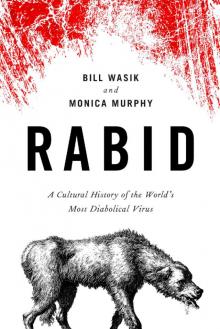- Home
- Monica Murphy
Rabid
Rabid Read online
RABID
ALSO BY BILL WASIK
And Then There’s This:
How Stories Live and Die in Viral Culture
Frontispiece of a book about a plague in Venice, 1657.
RABID
A CULTURAL HISTORY OF THE
WORLD’S MOST DIABOLICAL VIRUS
BILL WASIK AND
MONICA MURPHY
VIKING
VIKING
Published by the Penguin Group
Penguin Group (USA) Inc., 375 Hudson Street, New York, New York 10014, U.S.A. • Penguin Group (Canada), 90 Eglinton Avenue East, Suite 700, Toronto, Ontario, Canada M4P 2Y3 (a division of Pearson Penguin Canada Inc.) • Penguin Books Ltd, 80 Strand, London WC2R 0RL, England • Penguin Ireland, 25 St. Stephen’s Green, Dublin 2, Ireland (a division of Penguin Books Ltd) • Penguin Books Australia Ltd, 250 Camberwell Road, Camberwell, Victoria 3124, Australia (a division of Pearson Australia Group Pty Ltd) • Penguin Books India Pvt Ltd, 11 Community Centre, Panchsheel Park, New Delhi–110 017, India • Penguin Group (NZ), 67 Apollo Drive, Rosedale, Auckland 0632, New Zealand (a division of Pearson New Zealand Ltd) • Penguin Books (South Africa) (Pty) Ltd, 24 Sturdee Avenue, Rosebank, Johannesburg 2196, South Africa
Penguin Books Ltd, Registered Offices:
80 Strand, London WC2R 0RL, England
First published in 2012 by Viking Penguin,
a member of Penguin Group (USA) Inc.
10 9 8 7 6 5 4 3 2 1
Copyright © Bill Wasik and Monica Murphy, 2012
All rights reserved
Image credits
Pages iv and xii: Wellcome Library, London; 14: © Leeds Museums and Art Galleries (City Museum), UK / The Bridgeman Art Library International; 38 and 202: Photograph by the authors; 64: © The Trustees of the British Museum; 90: Private Collection / Peter Newark American Pictures / The Bridgeman Art Library; 118: Bibliothèque des Arts décoratifs, Paris / Archives Charmet / The Bridgeman Art Library; 150: Penguin Group (USA) Inc.; 180: Annals of Internal Medicine; 224: Digital image © 2011 Museum Associates / LACMA. Licensed by Art Resource, NY.
Library of Congress Cataloging-in-Publication Data
Wasik, Bill.
Rabid : a cultural history of the world’s most diabolical virus / Bill Wasik and Monica Murphy.
p. cm.
Includes index.
ISBN: 978-1-101-58374-6
1. Rabies—Epidemiology—History. 2. Rabies—Treatment—History. I. Murphy, Monica.
II. Title.
RC148.W37 2012
614.5’63—dc23 2011043903
Printed in the United States of America
Set in Haarlemmer with Engravers
Designed by Daniel Lagin
No part of this book may be reproduced, scanned, or distributed in any printed or electronic form without permission. Please do not participate in or encourage piracy of copyrighted materials in violation of the author’s rights. Purchase only authorized editions.
ALWAYS LEARNING
PEARSON
For our “creatures”—Emmett and Mia
CONTENTS
INTRODUCTION
LOOKING THE DEVIL IN THE EYE
CHAPTER 1
IN THE BEGINNING
CHAPTER 2
THE MIDDLE RAGES
CHAPTER 3
A VIRUS WITH TEETH?
CHAPTER 4
CANICIDE
CHAPTER 5
KING LOUIS
CHAPTER 6
THE ZOONOTIC CENTURY
CHAPTER 7
THE SURVIVORS
CHAPTER 8
ISLAND OF THE MAD DOGS
CONCLUSION
THE DEVIL, LEASHED
ACKNOWLEDGMENTS
NOTES
INDEX
From a Spanish edition of Dioscorides’ De Materia Medica, 1566.
INTRODUCTION
LOOKING
THE DEVIL
IN THE EYE
Ours is a domesticated age. As human civilization has spread itself out over the march of millennia, displacing wildlife as we go, we have found it advisable to strip the animal kingdom of its armies, to decommission its officers. Some of these erstwhile adversaries we have hunted to extinction, or nearly so. Others we relegate to zoos, confine in child-friendly safari parks. The balance we shunt to the margins as we clear the land for ourselves—erecting our own sprawling habitats on the ruins of theirs, naming our cul-de-sacs for whatever wilderness we dozed to pave them.
Peer through news reports, though, and one can find pockets of resistance, as if some ancient animal instinct were furtively reasserting itself. Consider the kamikaze bobcat in Cottonwood, Arizona, that set out on a rampage one recent March evening, menacing a worker outside a Pizza Hut and then sauntering into a bar, sending patrons onto the pool table, mauling the one who dared to snap a picture on his phone. Or the frenzied otter in Vero Beach, Florida, at a waterfront golf community called Grand Harbor, that gnawed three residents, one of them while out on the links. Or the enraged beaver in the Loch Raven Reservoir, in the genteel exurban sprawl north of Baltimore, that cruelly interrupted the summertime reverie of four swimmers; it was deterred from devouring them only when the husband of one victim pulled it from her thigh and smashed it with a large rock.
Typically, such wildlife shuns the society of humans. But in an instant we can find these meek woodland creatures transformed into bewilderingly avid attackers, accosting us as we retrieve our mail or walk our dogs. Sometimes they will even attempt a home invasion, as one young couple in the Adirondack hamlet of Lake George, New York, learned on an April evening just a few years ago. Walking from their car, they were set upon by a gray fox; they managed to rush inside their home and close the door. But nearly a half hour later, when they opened the door again, the fox lay in wait; it sprinted toward the opening. Only quick reflexes allowed the young man to close it just as the devil’s snout broached the threshold. When an animal control officer arrived, the fox attacked his SUV, repeatedly sinking its teeth into the vehicle’s tires. He shot at it multiple times from out his driver’s side window but failed to hit his mark. Later, after the officer had finally run the fox over, he told a reporter that it was the single most aggressive foe he had encountered in nine years on the job. “This was a four- or five-pound animal attacking a 3,000-pound vehicle,” he said.
The sheer tenacity: that is the truly chilling element in all these tales. “What disturbs me,” remarked one Connecticut man to the local news, regarding the raccoon he had lately beaten to death with a hammer, “is I smashed his mouth off, I smashed his teeth in, but he still wanted to continue in the attack mode. I was actually terrified at the resilience of this animal.” In Putnam County, New York, a similarly determined raccoon assaulted one victim at the end of her half-mile-long driveway. She held down the beast while attempting to free her cell phone to call the house; eventually, her husband and son had to club the raccoon repeatedly with a tire iron in order to kill it. (“I felt that nature had betrayed me,” she later told a reporter for the public-radio show This American Life.) Then there was the red fox in South Carolina that pursued a nine-year-old as he walked to the school bus one morning. After an adult neighbor sheltered the boy, the fox latched on to the Good Samaritan’s foot. He flung the animal into his home office, where it flailed against the walls and windows before finally falling asleep on a dog bed.
Nearly any species can be afflicted. Arizona officials were recently called to the scene after a dog was attacked by a mad peccary, a piglike creature whose residence in the Southwest had until that point been considered largely peaceable. In Robbins, North Carolina, it was a skunk that beset the pet Pekingese of David Sanders, who was forced to watch the two creatures battle it out for the better part of an hour. In Decatu
r County, Georgia, a donkey fell prey to the madness and bit its owner on the hand. In Imperial, Nebraska, the afflicted animal was literally a lamb, part of a child’s 4-H project gone terribly, almost biblically awry. Some primeval force must truly be at work when the lamb can be made into a lion.
The agent of all these acts of possession is, of course, a virus. It is the most fatal virus in the world, a pathogen that kills nearly 100 percent of its hosts in most species, including humans. Fittingly, the rabies virus is shaped like a bullet: a cylindrical shell of glycoproteins and lipids that carries, in its rounded tip, a malevolent payload of helical RNA. On entering a living thing, it eschews the bloodstream, the default route of nearly all viruses but a path heavily guarded by immuno-protective sentries. Instead, like almost no other virus known to science, rabies sets its course through the nervous system, creeping upstream at one to two centimeters per day (on average) through the axoplasm, the transmission lines that conduct electrical impulses to and from the brain. Once inside the brain, the virus works slowly, diligently, fatally to warp the mind, suppressing the rational and stimulating the animal. Aggression rises to fever pitch; inhibitions melt away; salivation increases. The infected creature now has only days to live, and these he will likely spend on the attack, foaming at the mouth, chasing and lunging and biting in the throes of madness—because the demon that possesses him seeks more hosts.
If this sounds like a horror movie, we should not be surprised, for it is a scenario bound up into our very concept of horror. Rabies is a scourge as old as human civilization, and the terror of its manifestation is a fundamental human fear, because it challenges the boundary of humanity itself. That is, it troubles the line where man ends and animal begins—for the rabid bite is the visible symbol of the animal infecting the human, of an illness in a creature metamorphosing demonstrably into that same illness in a person.
Today, we understand that more than half our new diseases (60 percent, by a recent tally in Nature) are “zoonotic”—that is, originating in animal populations—and our widespread fear of the worst of these (swine flu, AIDS, West Nile, Ebola) has been colored by our knowledge of their bestial origins. It is hardly an exaggeration to say that nothing has made humans sicker than our association with animals. Not only our emerging diseases today but the major killers throughout the ages—smallpox, tuberculosis, malaria, influenza—evolved from similar diseases in animals. This is what Jared Diamond has called “the lethal gift of livestock,” a major shaper of human destiny; the very fact that the farmer won out over the hunter-gatherer is due in part, Diamond argues, to the fact that the former “breathed out nastier germs.” Through their close contact with animals, early farmers built up immunity to illnesses that would readily kill unexposed populations, a dynamic that still holds for emerging infectious diseases today.
Yet until the twentieth century, humans had no idea that so many of their illnesses derived from nonhuman hosts. During those years when the most catastrophic zoonosis in history struck—the fourteenth-century Black Death, or bubonic plague, which spreads to humans via fleas living on the backs of rats and other rodents—scholars blamed nearly everything else, from demonic forces and bad air to astronomical happenings and even human malefactors. For centuries, rabies was the only illness in which the animalistic transfer, or more like a transformation, was evident. No microscope was required to see the possession take place. A mad animal bit; a mad man appeared; each would die a terrible death. The madness could lurk within any mammal, even in—especially in—the most domesticated and loyal of all, the dog.
As the lone visible instance of animal-to-human infection, rabies has always shaded into something more supernatural: into bestial metamorphoses, into monstrous hybridities. When Greek myth beholds Lycaon, king of Arcadia, as he transforms into a slavering wolf, his countenance is “rabid,” his jaws “bespluttered with foam.” In fifteenth-century Spain, witch-hunters called saludadores were reputed, also, as healers of rabies, a convergence that made eminent sense given the widely held association between witches and their demonic canine “familiars.” Between the fifteenth and the eighteenth centuries, Europe gestated two enduring legends whose part-human, part-animal villains bite their victims, thereby passing along their own degraded conditions—namely, the werewolf and the vampire, both of whom haunt the Western imagination to the present day. The essayist Susan Sontag noted that even as late as the nineteenth century, when viruses were becoming well understood and a rabies vaccine lay within reach, the true source of the rabies panics in France was not the fatality of the disease but rather the “fantasy”—though one might accurately say the fact—“that infection transformed people into maddened animals.”
Paradoxically, during the twentieth century, after Pasteur’s invention of a rabies vaccine provided a near-foolproof means of preventing its fatality in humans, our dark fascination with rabies seemed only to swell. The vaccine itself became as mythologized as the bug, such that even today many Americans believe that treatment requires some twenty (or is it thirty?) shots, delivered with a foot-long syringe into the stomach. (In fact, today’s vaccine entails four shots, and not particularly deep in the arm.) Even as vaccination of dogs in the United States was reducing the infection rate in that species down to negligible levels, a generation of children learned to scrutinize their pet pooches for the slightest signs of madness, thanks in part to the lamentable influence of Old Yeller, a Walt Disney film about a frontier-era boy who falls in love with a yellow dog that becomes rabid. Twenty-four years later, a novel called Cujo (and its subsequent film adaptation) taught a whole new generation to fear rabies, albeit a bit more forthrightly: no one finished the book or left the theater surprised by what became of that nice dog.
It’s almost as if the very anachronism of rabies, to the Western mind, has rendered it even more intriguing to us. Like the vampire, rabies carries with it the musty whiff of a centuries-old horror, even as it still terrifies us in the present day. Lately, TV comedians have taken to seizing on it for a laugh: two animated series created by Mike Judge, King of the Hill and Beavis and Butt-Head, have done episodes on rabies, as did the long-running medical comedy Scrubs. In the U.S. version of The Office, Michael Scott (the bumbling boss played by Steve Carell) tries to paper over the fact that he has hit an employee with his car by organizing a charity “race for the cure.” The disease he chooses is rabies. He soon becomes perplexed, though, at how few donations are forthcoming:
Michael Scott: I was also hoping to hand the giant check to a rabies doctor. How’s that going?
Pam Beesly: Not well. A doctor won’t come out to collect a check for seven hundred dollars. Or five hundred dollars, if we go with the giant check. And also, there is no such thing as a rabies doctor.
Contrary to what your television may have told you, there are most assuredly still rabies doctors, and humans still die in the tens of thousands from the disease every year (fifty-five thousand, in the estimate of the World Health Organization). But few of these deaths happen in the United States or in western Europe. The dead hail overwhelmingly from Asia and Africa, from countries where vaccination is too expensive or too difficult to procure. And the course of their suffering is every bit as grim, and as inevitably fatal, as that endured by victims throughout the millennia.
Indeed, other than the wide availability of sedatives, which can subdue the final agonies of the disease, the sequence of horrors faced by a typical rabies patient today is hardly different from those experienced by the man who was probably the most eminent rabies victim in history: Charles Lennox, fourth Duke of Richmond, who for the two years leading up to his death in 1819 served as governor-general of Canada, the top post in what was then still a colonial government. The duke was a famous lover of dogs; a portrait of Lennox as a boy shows the young nobleman reclining against a tree stump as an adoring spaniel paws at his finery. Ironically, it was not a dog but rather a fox, the ostensibly tame pet of a soldier whose garrison the duke had occasion to inspect
in Quebec, whose jaws were to blame for his demise. When the fox tangled with the duke’s own dog—Blucher, so named in honor of Gebhard Leberecht von Blücher, the Prussian general who had recently bested Napoleon at Waterloo—Lennox manfully stepped in to separate the two. The mad fox seized this chance to insult the visiting dignitary, chomping down hard on the base of his thumb.
After a bite, the rabies virus binds quickly into the peripheral nerves but then makes its course with almost impossible sloth, usually requiring at least three weeks and often as long as three months to arrive at and penetrate the brain. On rare occasions a full year, or even five years, can elapse before the onset of symptoms. During this time the wound will heal over, and the victim may even forget about his scrape with a snarling beast. But healed or no, as the virus enters the brain, the wound will usually seem to return, as if by magic, with some odd sensation occurring at the site. This sensation can take many forms: stabbing pain, or numbness; burning, or unnatural cold; tingling, or itching; or even a tremor. At roughly the same time, these soon-to-be-doomed patients typically display general signs of influenza, with a fever and perhaps a sore throat or some mild nausea. In the case of the Duke of Richmond, it began one day with shoulder pains and a sore throat, then progressed the following day to insomnia and fatigue.
All this is merely prelude to the illness itself, whose most notable symptom in humans—unique, as far as physicians know, to rabies among all diseases—is a terrifying condition called hydrophobia. As the term suggests, hydrophobia is a fear of water, though the word “fear” does not do justice to the eerie and fully physical manner in which it manifests. Present the hydrophobic patient with a cup of water and, desperately though he wants to drink it, his entire body rebels against the consummation of this act. The outstretched arm jerks away just as it is about to bring the cup to the parched lips. Other times the entire body convulses at the thought. Just beholding the water can make the diaphragm involuntarily contract, causing patients to gag and retch. On YouTube one can find video from a 2007 sufferer in Vietnam, showing the travails of a middle-aged construction worker as he attempts to consume some dark beverage from a clear plastic cup. He brings the vessel two-thirds of the distance to his lips before his hands begin to tremble uncontrollably. He stares at the fluid, mouth agape, his twitching hands sloshing it over the sides. Finally he forces himself to bring the tiniest sip into his mouth and, overcoming the revulsion in his gullet, to swallow it.

 Second Chance Boyfriend (Drew + Fable)
Second Chance Boyfriend (Drew + Fable) One Week Girlfriend
One Week Girlfriend The Junior (College Years Book 3)
The Junior (College Years Book 3) The Senior (College Years Book 4)
The Senior (College Years Book 4) The Freshman
The Freshman Meant To Be (The Callahans Book 4)
Meant To Be (The Callahans Book 4) Nothing Without You
Nothing Without You Thinking About You
Thinking About You Fake Date
Fake Date Her Defiant Heart
Her Defiant Heart Close to Me
Close to Me Holidate
Holidate Fair Game (The Rules Book 1)
Fair Game (The Rules Book 1) Addicted To Him
Addicted To Him Wedding Date (Dating Series Book 6)
Wedding Date (Dating Series Book 6) Damaged Hearts, Book 3
Damaged Hearts, Book 3 Never Let You Go (Never #2)
Never Let You Go (Never #2) One Night (Friends #0.5)
One Night (Friends #0.5) Never Tear Us Apart (Never Tear Us Apart #1)
Never Tear Us Apart (Never Tear Us Apart #1) Just Friends
Just Friends Drew + Fable Forever (Novella)
Drew + Fable Forever (Novella) His Wasted Heart
His Wasted Heart Three Broken Promises
Three Broken Promises Torn: A Billionaire Bachelors Club Novel
Torn: A Billionaire Bachelors Club Novel Her Defiant Heart - Monica Murphy
Her Defiant Heart - Monica Murphy More than Friends - Monica Murphy
More than Friends - Monica Murphy Taming Lily
Taming Lily His Reverie
His Reverie In The Dark
In The Dark Rabid
Rabid Saving It
Saving It Pretty Dead Girls
Pretty Dead Girls Daring the Bad Boy
Daring the Bad Boy Savor: A Billionaire Bachelors Club Novel
Savor: A Billionaire Bachelors Club Novel Four Years Later
Four Years Later Her Destiny
Her Destiny You Promised Me Forever
You Promised Me Forever The Sophomore
The Sophomore Damaged Hearts - Monica Murphy
Damaged Hearts - Monica Murphy Fair Game (The Rules #1)
Fair Game (The Rules #1) Crave
Crave Slow Play
Slow Play Blind Date (Dating Series Book 7)
Blind Date (Dating Series Book 7) Stealing Rose
Stealing Rose Forever: A Friends Novel
Forever: A Friends Novel Five Days Until You
Five Days Until You Safe Bet (The Rules #4)
Safe Bet (The Rules #4) Owning Violet
Owning Violet Intoxicated
Intoxicated